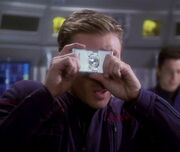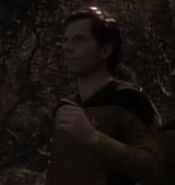A Camera is a device which captures visual data in a way that makes it possible for a scene that was captured to be re-created at a later time.
Types of cameras
Single-frame camera

Tucker with single-frame camera
Single-frame cameras capture one moment from one point in one direction.
In 2151, Trip Tucker used such a device to take still images on an unknown planet, later named Archer IV. (ENT: "Strange New World")
He later used one to take a photo of Jonathan Archer in his captain's chair to be sent to an artist in Oakland who was to paint a portrait of the captain that was to be placed in Starfleet Command. (ENT: "Rogue Planet")
Multi-frame camera
Multi-frame cameras, often called video cameras, capture several frames per second and store them sequentially. The frames are later displayed in sequence, changing at the same frequency that they were captured. These cameras often include audio recording capability as well, synchronizing the sampled audio with the sequence of images.
When the USS Voyager was thrown back in time and space to 1996 Earth, a man caught Voyager in low orbit with his video camera during a barbecue. (VOY: "Future's End")
In 2155, Gannet Brooks employed a head-mounted video camera. (ENT: "Demons")
In 2266, Montgomery Scott installed what appeared to be a video camera aboard the USS Enterprise to record the wedding of Angela Martine and Robert Tomlinson. (TOS: "Balance of Terror")
On 892-IV, live-action cameras were used to broadcast television programs, such as Name the Winner, in 2268. (TOS: "Bread and Circuses")
On Ekos. (TOS: "Patterns of Force")
In 2293, three reporters (two males and one female) covering the maiden voyage of the USS Enterprise-B wore head-mounted cameras. Upon Captain Kirk being asked for advice on how to proceed with the voyage when it ran into trouble, the second command he gave was for one of the camera operators to "turn that damned thing off." Each of these cameras had two lenses on either side of the wearer's head and a white, electric light on the left side, between the left-side lens and the user's left ear. The lens on the right side was adjustable but was typically positioned in front of the wearer's right eye. A blinking red light could also be found on the camera's right side. (Star Trek Generations)
In 2367, Lieutenant Junior Grade Anthony Brevelle wore a head-mounted camera during an investigation of missing Starfleet personnel on Tarchannen III. The image data collected was later used to discover an invisible species of alien. This device could be programmed to include data in the recording, like the stardate or the time of recording. It also included a light source that could be switched on if the surroundings were too dark. (TNG: "Identity Crisis")
Holographic camera
A holographic camera, also called holo-imager or holo-recorder, takes three-dimensional images called holograms.
- See also: Holophotography.
Other references
- TOS: "Tomorrow is Yesterday"
- ENT: "Rogue Planet"
- ENT: "Shadows of P'Jem"
- ENT: "Horizon"

